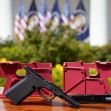On Friday, the U.S. Supreme Court overturned the federal ban on bump stocks, the rapid-fire gun accessory used in the deadliest mass shooting in U.S. history. The ruling was decided by a 6-3 majority, with conservative justices prevailing.
A bump stock is a device that attaches to a semi-automatic rifle, allowing it to fire more rapidly by using the gun's recoil to "bump" the trigger against the shooter's finger repeatedly. This mechanism simulates automatic fire without converting the firearm to fully automatic.
The bump stock ban was originally instituted by the Trump administration in response to the tragic 2017 mass shooting in Las Vegas, where the shooter used bump stocks to kill 58 people at a Route 91 Harvest country music festival. Then-President Trump advocated for the ban, prompting the Bureau of Alcohol, Tobacco, Firearms, and Explosives (ATF) to classify bump stocks as machine guns under the National Firearms Act.
The National Rifle Association (NRA) and other gun rights proponents have applauded the decision. They argued that the ATF exceeded its authority by imposing the ban without Congressional approval. The NRA praised the ruling as a necessary check on executive overreach, emphasizing that regulatory agencies should enforce laws rather than create new ones. This perspective aligns with a broader interpretation of the Second Amendment that opposes extensive regulatory measures on firearms.
Justice Sonia Sotomayor, representing the court’s liberal wing, issued a strong dissent. She argued that bump stocks effectively convert semi-automatic rifles into the functional equivalent of machine guns, challenging the majority's interpretation. Sotomayor emphasized her disagreement by reading a summary of her dissent from the bench, a rare move signaling profound disapproval.
Justice Clarence Thomas, writing for the majority, stated that a firearm equipped with a bump stock does not meet the federal definition of a machine gun. The court held that the statutory language defining machine guns, established nearly a century ago, could not be stretched to include rapid-fire gun accessories.
Despite the Supreme Court’s ruling, bump stocks remain banned in 18 states.






